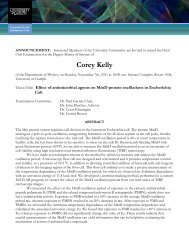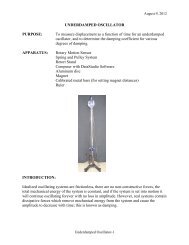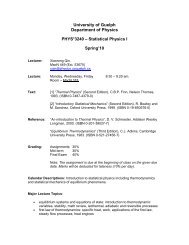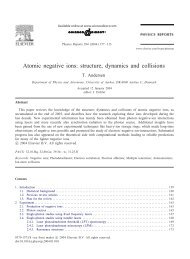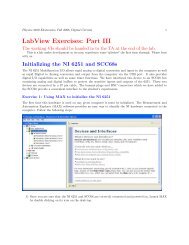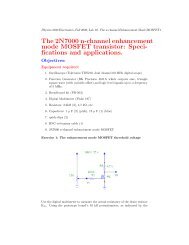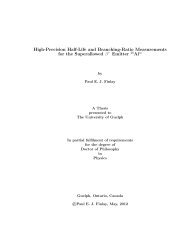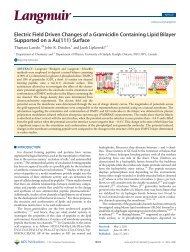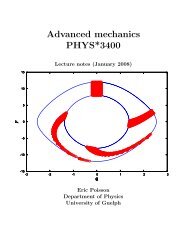Geant4 Simulations for the Radon Electric Dipole Moment Search at
Geant4 Simulations for the Radon Electric Dipole Moment Search at
Geant4 Simulations for the Radon Electric Dipole Moment Search at
Create successful ePaper yourself
Turn your PDF publications into a flip-book with our unique Google optimized e-Paper software.
was to use an average X-ray energy per vacancy. These tables <strong>for</strong> all elements were<br />
coded directly into <strong>the</strong> <strong>Geant4</strong> simul<strong>at</strong>ion. The o<strong>the</strong>r more accur<strong>at</strong>e option was to<br />
provide an input file of <strong>the</strong> X-ray energies and intensities per shell vacancy. This<br />
method was important to accur<strong>at</strong>ely simul<strong>at</strong>e Fr K shell vacancies as <strong>the</strong> energy<br />
of <strong>the</strong> X rays approach 100 keV, which are easily measured and resolved within<br />
<strong>the</strong> GRIFFIN γ-ray detectors. The input d<strong>at</strong>a <strong>for</strong> Fr K shell vacancies is given in<br />
Table 3.2. Careful inspection of <strong>the</strong>se d<strong>at</strong>a reveals <strong>the</strong> intensities total to gre<strong>at</strong>er than<br />
100% (per 100 K-shell vacancies). For every K vacancy one or more X-rays may be<br />
emitted. For example, an electron from <strong>the</strong> L shell can drop down and occupy <strong>the</strong><br />
K shell vacancy, while leaving a new vacancy in <strong>the</strong> L shell. Ano<strong>the</strong>r electron will<br />
cascade down from <strong>the</strong> M shell to fill <strong>the</strong> L shell vacancy and so on. This process<br />
was incorpor<strong>at</strong>ed into <strong>the</strong> <strong>Geant4</strong> simul<strong>at</strong>ions to provide an accur<strong>at</strong>e simul<strong>at</strong>ion of<br />
<strong>the</strong> entire X-ray cascade following internal conversion.<br />
3.4 Simul<strong>at</strong>ing Angular Distributions<br />
3.4.1 Beta Particle Anisotropies<br />
The directional distribution of β particles from aligned nuclei has <strong>the</strong> <strong>for</strong>m [50]<br />
W(θ) = 1+A β P cos(θ), (3.8)<br />
where A β is <strong>the</strong>beta-asymmetry correl<strong>at</strong>ioncoefficient, P is<strong>the</strong>degree ofpolariz<strong>at</strong>ion<br />
and θ is <strong>the</strong> angle of emission rel<strong>at</strong>ive to <strong>the</strong> polariz<strong>at</strong>ion axis. The beta-asymmetry<br />
correl<strong>at</strong>ion coefficient depends on <strong>the</strong> initial and final spins and parities of <strong>the</strong> nuclear<br />
levels, as well as <strong>the</strong> rel<strong>at</strong>ive contributions of Fermi and Gamow-Teller β decay <strong>for</strong><br />
mixed transitions. These input d<strong>at</strong>a are not known <strong>for</strong> many of <strong>the</strong> β decay branches<br />
47



